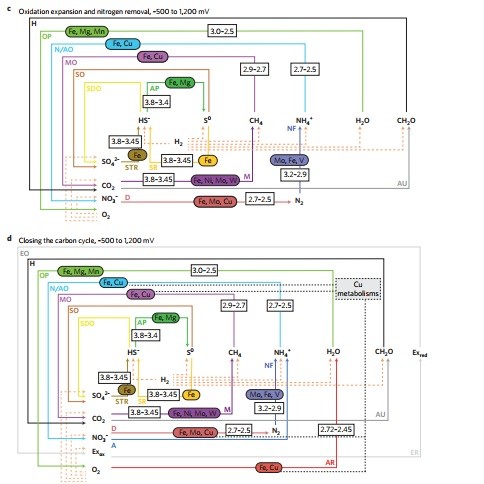Nature Geoscience ( IF 18.3 ) Pub Date : 2017-08-28 , DOI: 10.1038/ngeo3006 Eli K. Moore , Benjamin I. Jelen , Donato Giovannelli , Hagai Raanan , Paul G. Falkowski

|
Life is based on energy gained by electron-transfer processes; these processes rely on oxidoreductase enzymes, which often contain transition metals in their structures. The availability of different metals and substrates has changed over the course of Earth's history as a result of secular changes in redox conditions, particularly global oxygenation. New metabolic pathways using different transition metals co-evolved alongside changing redox conditions. Sulfur reduction, sulfate reduction, methanogenesis and anoxygenic photosynthesis appeared between about 3.8 and 3.4 billion years ago. The oxidoreductases responsible for these metabolisms incorporated metals that were readily available in Archaean oceans, chiefly iron and iron–sulfur clusters. Oxygenic photosynthesis appeared between 3.2 and 2.5 billion years ago, as did methane oxidation, nitrogen fixation, nitrification and denitrification. These metabolisms rely on an expanded range of transition metals presumably made available by the build-up of molecular oxygen in soil crusts and marine microbial mats. The appropriation of copper in enzymes before the Great Oxidation Event is particularly important, as copper is key to nitrogen and methane cycling and was later incorporated into numerous aerobic metabolisms. We find that the diversity of metals used in oxidoreductases has increased through time, suggesting that surface redox potential and metal incorporation influenced the evolution of metabolism, biological electron transfer and microbial ecology.
中文翻译:

古生菌时代的金属可用性和微生物代谢网络的扩展
生命是基于电子转移过程中获得的能量。这些过程依赖于氧化还原酶,该酶通常在其结构中包含过渡金属。由于氧化还原条件(特别是全球氧合作用)的长期变化,在地球历史过程中,各种金属和基材的可利用性发生了变化。随着氧化还原条件的变化,使用不同过渡金属的新代谢途径也共同发展。约3.8至34亿年前出现了硫还原,硫酸盐还原,甲烷生成和无氧光合作用。负责这些新陈代谢的氧化还原酶掺入了古细菌海洋中容易获得的金属,主要是铁和铁硫簇。氧合光合作用出现在3.2到25亿年前,甲烷氧化也是如此,固氮,硝化和反硝化。这些新陈代谢依赖于可能在土壤结皮和海洋微生物垫中积累的分子氧而提供的过渡金属的扩大范围。在大氧化事件之前,酶中铜的分配尤为重要,因为铜是氮和甲烷循环的关键,后来被纳入许多有氧代谢中。我们发现,氧化还原酶中所用金属的多样性随着时间的推移而增加,这表明表面氧化还原电势和金属掺入影响了代谢,生物电子转移和微生物生态学的演变。这些新陈代谢依赖于可能在土壤结皮和海洋微生物垫中积累的分子氧而提供的过渡金属的扩大范围。在大氧化事件之前,酶中铜的分配尤为重要,因为铜是氮和甲烷循环的关键,后来被纳入许多有氧代谢中。我们发现,氧化还原酶中所用金属的多样性随着时间的推移而增加,这表明表面氧化还原电势和金属掺入影响了代谢,生物电子转移和微生物生态学的演变。这些新陈代谢依赖于可能在土壤结皮和海洋微生物垫中积累的分子氧而提供的过渡金属的扩大范围。在大氧化事件之前,酶中铜的分配尤为重要,因为铜是氮和甲烷循环的关键,后来被纳入许多有氧代谢中。我们发现,氧化还原酶中所用金属的多样性随着时间的推移而增加,这表明表面氧化还原电势和金属掺入影响了代谢,生物电子转移和微生物生态学的演变。因为铜是氮和甲烷循环的关键,后来被纳入许多有氧代谢中。我们发现,氧化还原酶中所用金属的多样性随着时间的推移而增加,这表明表面氧化还原电势和金属掺入影响了代谢,生物电子转移和微生物生态学的演变。因为铜是氮和甲烷循环的关键,后来被纳入许多有氧代谢中。我们发现,氧化还原酶中所用金属的多样性随着时间的推移而增加,这表明表面氧化还原电势和金属掺入影响了代谢,生物电子转移和微生物生态学的演变。



























 京公网安备 11010802027423号
京公网安备 11010802027423号